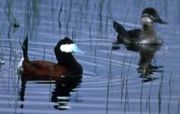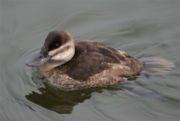
Ruddy Duck
Encyclopedia
The Ruddy Duck is a small stiff-tailed duck
.
 Their breeding habitat is marshy lakes and ponds throughout much of North America
Their breeding habitat is marshy lakes and ponds throughout much of North America
, and in South America
in the Andes
. They nest in dense marsh vegetation near water. The female builds her nest out of grass, locating it in tall vegetation to hide it from predators. A typical group of young ranges from 5-15 ducklings. Pairs form each year.
Adult males have a rust-red body, a blue bill, and a white face with a black cap. Adult females have a grey-brown body with a greyish face with a darker bill, cap and a cheek stripe. The southern subspecies ferruginea is occasionally considered a distinct species. It is separable by its all-black face and larger size. The subspecies andina has a varying amount of black coloration on its white face; it may in fact be nothing more than a hybrid population between the North American and the Andean Ruddy Duck. As the Colombian population is becoming scarce, it is necessary to clarify its taxonomic status, because it would be relevant for conservation purposes.
 They are migratory
They are migratory
and winter in coastal bays and unfrozen lakes and ponds.
These birds dive and swim underwater. They mainly eat seed
s and roots of aquatic plants, aquatic insect
s and crustacean
s.
As a result of escapes from wildfowl collections, they are now established in Great Britain
, from where they have spread widely into Europe
. This duck
's aggressive courting behaviour and willingness to interbreed with the endangered
native White-headed Duck
, Oxyura leucocephala, of southern Europe has caused some concern.
Due to this, there is now a controversial scheme to extirpate the Ruddy Duck as a British breeding species.
Stiff-tailed duck
The stiff-tailed ducks are part of the Oxyurinae subfamily of ducks. All have, as their name implies, long stiff tail feathers, which are erected when the bird is at rest. All have relatively large swollen bills.These are freshwater diving ducks...
.

North America
North America is a continent wholly within the Northern Hemisphere and almost wholly within the Western Hemisphere. It is also considered a northern subcontinent of the Americas...
, and in South America
South America
South America is a continent situated in the Western Hemisphere, mostly in the Southern Hemisphere, with a relatively small portion in the Northern Hemisphere. The continent is also considered a subcontinent of the Americas. It is bordered on the west by the Pacific Ocean and on the north and east...
in the Andes
Andes
The Andes is the world's longest continental mountain range. It is a continual range of highlands along the western coast of South America. This range is about long, about to wide , and of an average height of about .Along its length, the Andes is split into several ranges, which are separated...
. They nest in dense marsh vegetation near water. The female builds her nest out of grass, locating it in tall vegetation to hide it from predators. A typical group of young ranges from 5-15 ducklings. Pairs form each year.
Adult males have a rust-red body, a blue bill, and a white face with a black cap. Adult females have a grey-brown body with a greyish face with a darker bill, cap and a cheek stripe. The southern subspecies ferruginea is occasionally considered a distinct species. It is separable by its all-black face and larger size. The subspecies andina has a varying amount of black coloration on its white face; it may in fact be nothing more than a hybrid population between the North American and the Andean Ruddy Duck. As the Colombian population is becoming scarce, it is necessary to clarify its taxonomic status, because it would be relevant for conservation purposes.

Bird migration
Bird migration is the regular seasonal journey undertaken by many species of birds. Bird movements include those made in response to changes in food availability, habitat or weather. Sometimes, journeys are not termed "true migration" because they are irregular or in only one direction...
and winter in coastal bays and unfrozen lakes and ponds.
These birds dive and swim underwater. They mainly eat seed
Seed
A seed is a small embryonic plant enclosed in a covering called the seed coat, usually with some stored food. It is the product of the ripened ovule of gymnosperm and angiosperm plants which occurs after fertilization and some growth within the mother plant...
s and roots of aquatic plants, aquatic insect
Insect
Insects are a class of living creatures within the arthropods that have a chitinous exoskeleton, a three-part body , three pairs of jointed legs, compound eyes, and two antennae...
s and crustacean
Crustacean
Crustaceans form a very large group of arthropods, usually treated as a subphylum, which includes such familiar animals as crabs, lobsters, crayfish, shrimp, krill and barnacles. The 50,000 described species range in size from Stygotantulus stocki at , to the Japanese spider crab with a leg span...
s.
As a result of escapes from wildfowl collections, they are now established in Great Britain
Great Britain
Great Britain or Britain is an island situated to the northwest of Continental Europe. It is the ninth largest island in the world, and the largest European island, as well as the largest of the British Isles...
, from where they have spread widely into Europe
Europe
Europe is, by convention, one of the world's seven continents. Comprising the westernmost peninsula of Eurasia, Europe is generally 'divided' from Asia to its east by the watershed divides of the Ural and Caucasus Mountains, the Ural River, the Caspian and Black Seas, and the waterways connecting...
. This duck
Duck
Duck is the common name for a large number of species in the Anatidae family of birds, which also includes swans and geese. The ducks are divided among several subfamilies in the Anatidae family; they do not represent a monophyletic group but a form taxon, since swans and geese are not considered...
's aggressive courting behaviour and willingness to interbreed with the endangered
Endangered species
An endangered species is a population of organisms which is at risk of becoming extinct because it is either few in numbers, or threatened by changing environmental or predation parameters...
native White-headed Duck
White-headed Duck
The White-headed Duck is a small stiff-tailed duck.Adult males have a grey and reddish body, a blue bill and a largely white head with a black cap and neck. Adult females have a grey-brown body with a white face and a darker bill, cap and a cheek stripe.This duck breeds in Spain and North Africa,...
, Oxyura leucocephala, of southern Europe has caused some concern.
Due to this, there is now a controversial scheme to extirpate the Ruddy Duck as a British breeding species.
External links
- Ruddy Duck - Cornell Lab of Ornithology
- Ruddy Duck Oxyura jamaicensis - USGS Patuxent Bird Identification InfoCenter
- Ruddy Duck Information and Photos - South Dakota Birds and Birding
- The Royal Society for the Protection of Birds (in favor of the cull)
- Animal Aid (against)
- Massachusetts Breeding Bird Atlas-Ruddy Duck
- Ruddy Duck videos, photos & sounds on the Internet Bird Collection

